Back to Journals » Journal of Multidisciplinary Healthcare » Volume 16
Bibliometric Analysis of the Knowledge Landscape of Periodontal Disease in Pregnancy: A Noteworthy Multidisciplinary Issue
Authors Liu Z, Li Z , Wang L, Gu Z, Ma L
Received 25 August 2023
Accepted for publication 18 October 2023
Published 8 December 2023 Volume 2023:16 Pages 3941—3957
DOI https://doi.org/10.2147/JMDH.S437127
Checked for plagiarism Yes
Review by Single anonymous peer review
Peer reviewer comments 4
Editor who approved publication: Dr Scott Fraser
Zhihui Liu,1,* Zhuo Li,2,* Lingling Wang,3 Zhenpeng Gu,4 Lixin Ma5
1Department of Obstetrics and Gynecology, Beijing Chaoyang Hospital, Capital Medical University, Beijing, People’s Republic of China; 2School of Medicine, Nankai University, Tianjin, People’s Republic of China; 3Department of General Practice, Binzhou People’s Hospital, Binzhou, People’s Republic of China; 4Department of Obstetrics and Gynecology, Binzhou Medical University Hospital, Binzhou, People’s Republic of China; 5Department of Neurosurgery, Beijing Chaoyang Hospital, Capital Medical University, Beijing, People’s Republic of China
*These authors contributed equally to this work
Correspondence: Lixin Ma, Department of Neurosurgery, Beijing Chaoyang Hospital, Capital Medical University, No. 8 Gongti South Road, Chaoyang District, Beijing, People’s Republic of China, Email [email protected]
Background: Pregnant women are highly susceptible to periodontal disease due to changes in hormonal and immune levels, which places a huge burden on the healthcare system and requires multidisciplinary interventions. This study aimed to assess the scientific profile and research trends related to periodontal disease in pregnancy through a bibliometric approach.
Methods: Publications about periodontal disease in pregnancy from 2000 to 2022 were extracted from Science Citation Index Expanded. The knowledge networks of countries, institutions, authors, journals, references, and keywords in this field were constructed using the Citespace, VOSviewer, Bibliometrix, and BIBLIOMETRIC.COM platforms. Furthermore, correlations between the characteristics of countries and the number or impact of publications were analyzed.
Results: 1162 original studies and reviews were included. There was a trend toward increased publications and citations in this field. The United States had the highest academic productivity and impact by a significant margin, while correlation analyses indicated that economic power may correlate with national scientific activity. The University of North Carolina and Offenbacher S were the most influential institution and author, respectively, taking center stage in the collaborative networks. However, only several loose connections between countries or institutions were identified in the global collaborative network analysis. Six of the top ten most productive journals were in Q1 in the Journal Citation Report, and there was intensive interaction between different research subfields, such as immunology, molecular biology, and microbiology. Frontier topics were primarily clustered in two areas: (1) oral microbiology, such as microbiome, oral bacteria, and Fusobacterium nucleatum; and (2) public health, such as quality of life, pregnancy outcomes, oral health, obesity, and classification.
Conclusion: Since 2000, periodontal disease in pregnancy is receiving increasingly widespread attention and is rapidly evolving at a multidisciplinary level. Oral microbiological pathogenesis and public health impact-related research deserve more exploration and may be the future direction of research. Enhanced Collaboration and interdisciplinary communication may further facilitate progress in this discipline.
Keywords: bibliometric analysis, periodontal disease, pregnancy, multidisciplinary issue, oral microbiology, public health
Introduction
Periodontal disease is an oral inflammatory disease of heterogeneous etiology that could impair the gums and surrounding structures of the periodontal ligaments and alveolar bone.1,2 It is considered one of the most common diseases in humans1,3 and can lead to severe pain, bleeding, and even disability.4 For most women, the composition of the oral microbiome could undergo pathogenic shifts during pregnancy due to hormonal and immunological changes.5 Thus, pregnancy has been proposed to increase susceptibility to gingival inflammation further.6,7 A recent meta-analysis of 20 studies showed that the prevalence of periodontitis in pregnancy was as high as 40%.8
Additionally, maternal periodontal disease is strongly associated with poor pregnancy outcomes, such as preterm birth, low birth weight, and preeclampsia.9–11 However, dental treatment during pregnancy was unlikely to reduce the risk of these adverse pregnancy outcomes.12 Given its potential hazardous nature, tapping into the complicated bidirectional relationship between pregnancy and periodontal disease has become an essential interdisciplinary issue and is receiving close attention from scholars. However, the accelerated accumulation of knowledge within the field makes it especially challenging to understand the overall knowledge landscape and track the recent research hotspots, particularly for those new to the topic. In recent years, some systematic reviews of quantitative analyses on pregnancy and periodontal disease are available, which focus on specific subfields such as the prevalence of periodontal disease in pregnancy,13 oral microflora,13 associations of periodontal disease with different adverse outcomes,14–16 or specific interventions to improve prognosis.17–19 However, there is still a paucity of macroscopic analyses of the knowledge profile and topic evolution in the field.
The bibliometric analysis provides a well-established way to analyze large scale publications quantitatively and can systematically reveal macroscopic scientific profiles and research trends within a given field.20 Bibliometrics has been applied to various major public health studies, including osteoarthritis, dysmenorrhea, and COVID-19.21–24 Yet, it is still lacking in the area of periodontal disease in pregnancy. The objective of the present study is to provide a comprehensive analysis of publications on pregnancy and periodontal disease to deepen the understanding of knowledge profile and research trends in this field from a macro perspective.
Materials and Methods
Data Source
The Science Citation Index Extension (SCIE) was chosen as the data source. This database, established by the US Institute for Scientific Information, includes over 8000 of the most academically influential journals in the field of natural sciences and is recognized as the authoritative database for performing bibliometric studies. Furthermore, it can provide reference files in different formats that match the requirements of various bibliometric programs.25
Searching Strategy
Two researchers performed the literature search, source file download, and merge independently. The search strategy was set as TS= ((pregnan* OR gestat* OR reproduction OR gravidit* OR nulligravidit* OR primigravidit* OR fetation) AND periodont*) AND Time= (2000–2022) AND Language= English. After manually reviewing publications and excluding publication types such as corrections, editorial reviews, and conference proceedings, the final bibliometric dataset comprised 1162 academic publications. The data extraction was conducted in a single day (March 25, 2023) so as to prevent bias from database updates.
Bibliometric Analysis and Visualization
General bibliometric indicators were collected from the publication dataset, including country, affiliation, author, journal, keywords, and references. Publications were defined as either single-country publications (SCP) or multinational publications (MCP), depending on whether their authors originated from a single country. The metrics used to assess academic impact primarily include citations, the impact factor (IF, obtained from Journal Citation Reports, JCR 2022), H-index, and G-index. In addition, the number of publications per million people or per trillion gross domestic product (GDP) was also summarized, considering the considerable differences in population and economic size of different countries.
Knowledge networks for publications on pregnancy and periodontal disease were explored through the R packages Bibliometrix (version 3.0), VOSviewer (version 1.6.19), Citespace (version 6.2.R2), and the bibliometric.com online platform, including co-citation, co-occurrence, collaboration, co-authorship analysis, and burst detection. Spearman correlation analyses were performed using SPSS (version 22.0) for country characteristics and the number of publications, citations, or MCP proportions. P-values < 0.05 were considered statistically significant.
Results
General Information
The general information about 1162 publications is summarized in Table 1, including 918 original articles and 244 reviews. During the 23 years, such publications were contributed by 4720 authors, published in 373 journals, and cited 33,936 references. The average number of citations per document was 40.27, with an average of 3.538 per year. Figure 1A presents the annual trend of publications and citations for pregnancy and periodontal disease-related studies. A significant uptrend in both publications and citations can be observed, with a peak in 2022 at 88 publications and 5212 citations.
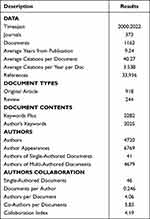 |
Table 1 Main Information About Bibliometric Analysis |
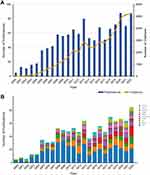 |
Figure 1 Annual publication trends for all countries (A) and the top 10 most productive countries (B). |
Publication Performances: Countries
Seventy-five countries participated in the study on periodontal disease in pregnancy. As summarized in Table 2, the United States of America (USA) was the most productive country by a considerable margin (n = 322, 28.1%), followed by Brazil (n = 107, 9.3%) and China (n = 60, 5.2%). Four of the top ten countries were from Europe, three were from Asia, and the other three were from North America, South America, and Oceania, respectively. Figure 1B shows that China had the most remarkable publication growth. When adjusted for the population or economic size of the country, Australia and Brazil topped the list with 1.8 publications per million people and 56.3 publications per trillion GDP, respectively. In addition, USA publications remained the most cited, receiving 22,433 citations; the United Kingdom was second with only 3031 citations. Chilean publications had the highest average article citation of 76.57. (Table 2)
 |
Table 2 Top 10 Productive Countries and Citations per Country |
Furthermore, correlation analysis revealed a correlation between the economic status of the country and the impact or internationalization of their publications (Supplementary Table 1). A moderate to high positive correlation existed between GDP per capita and MCP percentage (r= 0.815, P= 0.003) or average article citations (r= 0.550, P= 0.038). To explore the international collaboration status in this field, we further mapped the collaborative relationships to a pie chart (Figure 2A) and a global map (Figure 2B). We found that collaborations were primarily focused on USA-Europe-Australia and USA-East Asia. However, in general, the collaboration was not close, and the percentage of MCP was relatively low.
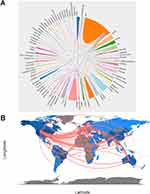 |
Figure 2 Country distribution of publications on periodontal disease in pregnancy (A) and international cooperation (B). |
Publication Performances: Institutions
More than 1800 institutions conducted pregnancy and periodontal disease-related research. The University of North Carolina (Univ N Carolina, n=143), Columbia University (Columbia Univ, n=56), and the University of Sydney (Univ Sydney, n=54) were the top three most productive institutions. Six of the top ten institutions were from the USA, and two were from Europe (Figure 3A). The collaboration analysis identified four major clusters (Figure 3B): Univ N Carolina, University of Sao Paulo (Univ Sao Paulo), Columbia Univ, and Wayne State University (Wayne State Univ) were located at the center of each cluster. The time-series-based co-authorship network revealed complicated collaborative relationships between institutions, with Univ N Carolina being the most prominent node (Figure 3C). In addition, many institutions newly involved in the field have recently emerged, such as University of Maryland (Univ Maryland), University of Hong Kong (Univ Hong Kong), and Johns Hopkins University (Johns Hopkins Univ).
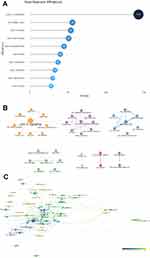 |
Figure 3 The top 10 most productive institutions (A), collaboration of institutions (B), and co-authorship network (C). |
Publication Performances: Authors
The top 10 most productive authors are presented in Figure 4A. The Offenbacher S ranked first with 42 publications, twice as many as the second-ranked Boggess Ka. As for the most academically influential scholars, Offenbacher S received 1222 citations with an H-index of 24 and a G-index of 42 (Supplementary Table 2). Goldenberg Rl and Hauth Jc were followed by 574 and 2105 citations, respectively. Notably, the top ten most cited scholars were all from the USA. Additionally, only a few loose clusters of authors were identified in the collaborative network, with Offenbacher S at the center of the largest cluster (Figure 4B). We further analyzed the annual academic performance of the top ten productive authors over the last 20 years (Figure 4C). Six scholars have worked in this field for over 15 years; however, few still have scholarly output today.
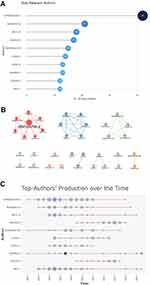 |
Figure 4 The top 10 most productive authors (A), collaboration of authors (B), and top authors’ production over time (C). |
Highly Contributive Journals
As demonstrated in Table 3, the most productive journal was the Journal of Periodontology, with 118 publications and 4438 citations. The Journal of Clinical Periodontology (n=73, citations=5271) and the American Journal of Obstetrics and Gynecology (n=30, citations=1722) were in second and third place. The Periodontology 2000 had the highest IF of 12.239. Notably, six of the top ten journals were in JCR Q1 and two in JCR Q2. The co-citation network analysis identified three critical journal clusters (Figure 5A), including the dentistry cluster represented by the Journal of Periodontology, the obstetrics and gynecology cluster characterized by the American Journal of Obstetrics and Gynecology, and the microbiology and immunology cluster represented by Infection and Immunity and Oral Microbiology and Immunology. Furthermore, the journals’ dual-map overlap is shown in Figure 5B. The citing papers were concentrated in (1) Molecular, Biology, Immunology; (2) Dentistry, Dermatology, Surgery; (3) Medicine, Medical, Clinical. The cited papers were focused on: (1) Molecular, Biology, Genetics; (2) Health, Nursing, Medicine; (3) Dermatology, Dentistry, Surgery.
 |
Table 3 The Top Ten Most Productive Journals |
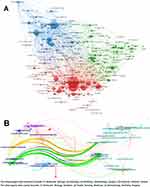 |
Figure 5 Co-citation network of the research journals (A), and a dual-map overlap of journals (B). |
Highly Contributive Papers
Local citations were used to determine the impact of the publications in this field. The top three influential articles were three prospective studies by Michalowicz B et al.26 Jeffcoat M et al27 and López NJ et al28 which explored the association between the presence of periodontal disease or interventions on adverse pregnancy outcomes. Co-citation analysis of the references revealed six interrelated clusters, illustrating the widespread connections between references (Figure 6A). Most of the top 25 references with the strongest citation bursts were published before 2010, indicating their enduring influence (Figure 6B). Two publications with high academic impact nowadays were authored by Madianos PN et al29 and Ao M et al.30 The study by Madianos PN et al summarized the pathogenic mechanisms of periodontal disease causing adverse pregnancy outcomes. While Ao M et al demonstrated that Porphyromonas gingivalis infection could induce preterm delivery in a mouse model.
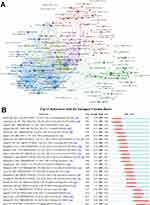 |
Figure 6 Co-citation network of references (A), and the top 25 references with the strongest citation bursts (B). |
Keyword Co-Occurrence
Keyword co-occurrence can assist us in quickly identifying research hotspots and development directions. Pregnancy and periodontal disease-related keywords can be divided into six major clusters (Figure 7A). The yellow cluster was mainly clinical outcomes-related keywords, including risk, outcome, prevention, and intervention. The cyan cluster primarily consists of keywords related to epidemiology, including epidemiology, population, and public health. The red and purple clusters corresponded to maternal and neonatal-related studies. Microbiology-related terms, such as pathogen, microbiome, and oral bacteria, were grouped in the green cluster. Besides, the temporal evolution of keywords indicated that emerging keywords were mainly concentrated in two fields: (1) oral microbiology, such as microbiome, oral bacteria, and Fusobacterium nucleatum; and (2) public health, such as quality of life, obesity, and classification (Figure 7B). The burst detection confirmed the above findings (Figure 8). Several keywords began to experience an intense burst after 2015 and still have a substantial impact by 2022, including dental care, periodontitis, consensus report, impact, classification, oral health, oral microbiome, oral bacteria, and obesity.
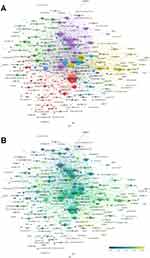 |
Figure 7 Cluster analysis (A) and temporal evolution analysis (B) of the keywords. |
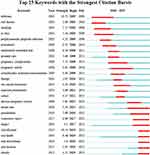 |
Figure 8 Burst detection of keywords reveals research hotspots. |
Discussion
As far as we know, the present study is the first bibliometric study on periodontal disease in pregnancy. We investigated 1162 publications between 2000 and 2022 to determine the characteristics and landmark achievements in this research field. We found an increasing trend in publications and citations in this field, indicating that this interdisciplinary field is receiving greater attention. The USA had the highest academic productivity and impact by a significant margin, while the evidence suggested that economic power may be correlated with national scientific activity. The Univ N Carolina and Offenbacher S were the most influential institution and scholar, respectively, as well as taking center stage in the collaborative networks. Six of the top ten most productive journals were JCR Q1, and there was intensive interaction between different research subfields, such as immunology, molecular biology, and microbiology. Frontier topics and research directions were primarily clustered in two areas: (1) oral microbiology, such as microbiome, oral bacteria, and Fusobacterium nucleatum; and (2) public health, such as quality of life, impact, oral health, obesity, and classification.
Periodontal Disease in Pregnancy Is Receiving Increasing Attention And Interdisciplinary Interaction is Active
Since women experience significant changes in their endocrine levels during pregnancy (primarily elevated estrogen and progesterone), the likelihood that a pregnant woman can develop the periodontal disease is subsequently elevated.31 Although most inflammatory periodontal lesions will gradually improve within one year after delivery, epidemiological investigations have found that pregnant women are susceptible to periodontal disease with multifactorial pathogenesis.31 The present study found that periodontal disease in pregnancy-related topics have attracted increasing interest. This trend may result from the high incidence of periodontal disease in pregnancy and the improved oral health awareness among pregnant women. Many epidemiological studies have investigated the prevalence of periodontal disease in pregnancy; however, the results vary widely due to inconsistencies in examination modalities and diagnostic criteria.10 A recent meta-analysis including 20 studies showed that the prevalence of periodontitis in pregnancy was 40%, with positive bleeding on probing, probing depth ≥4 mm, and loss of clinical attachment level≥4 mm 67%, 42%, and 24%, respectively.8 Moreover, the prevalence of periodontal disease may increase gradually during pregnancy.32 Considering the adverse effects of periodontal disease in pregnancy, this public health problem deserves more exploration.
Much of the pregnancy and periodontal disease-related literature were published in journals with significant academic impact, with six JCR Q1 and two JCR Q2 journals listed in the top ten productive journals. Moreover, journal co-citation analysis revealed that journals related to dentistry, obstetrics and gynecology, infection immunology, and microbiology are involved in researching the periodontal disease in pregnancy, representing a close interdisciplinary interaction.
USA is the Leader in This Field but Global Collaboration Still Needs to Be Strengthened
Regarding country contribution, the USA was the most productive, with three times more than Brazil. At the same time, the USA publications were cited seven times more than the UK, and the top ten most cited scholars were all from the USA. The USA also had close ties with Europe, Australia, and East Asia in collaborative networks. These results indicated that the USA was the most influential country in this field. Besides, our findings revealed that publications from countries with stronger economies had a higher percentage of MCP and received more citations, which may be due to the higher investment in scientific research and more intensive collaboration in developed countries.25,33 However, global collaboration in periodontal disease in pregnancy research remained infrequent, and increased international communication could yield more meaningful research findings.
Oral Microbiology is a Research Hotspot, and the Pathogenesis of Periodontal Disease Requires Further Exploration
More significantly, our bibliometric analysis revealed that oral microbiology research was a recent frontier topic. The pathogenesis of periodontal disease in pregnancy is an enduring topic. Since the end of the last century, scientists have recognized the potential relationship between periodontal disease and systemic diseases or women’s health issues,11,34 and have found that it is the result of a complex interplay between microbes, the host inflammatory response to plaque, and host factors.35 Based on keyword burst detection, an outburst of oral microbiology-related research began in 2019 and has continued to the present (Figure 6). Regarding publication trends, the number of publications and citations within this field were at a high level during these four years, significantly higher than those during the period 2014–2017 (Figure 1). The available evidence suggested that dysbiosis of oral microbial ecology was not only closely associated with systemic endocrine diseases such as diabetes mellitus36 but was also a leading cause of oral diseases, including periodontal disease.37 Several studies have indicated that although microbial diversity does not change significantly during pregnancy, its composition may undergo pathogenic shifts, which are regarded as a result of changes such as progesterone and estrogen.5,38 Furthermore, results from novel genomic sequencing technologies demonstrated that the complexity of the oral microbiome was much more significant than ever anticipated.39 Oral tissues during pregnancy can exhibit an increased inflammatory response to microorganisms. In addition, oral microbes have been found to be potentially associated with adverse pregnancy outcomes, which may result from their induced immune response.40 Clinical investigations of pregnant women with adverse pregnancy outcomes have revealed elevated levels of inflammatory factors in the gingival sulcus fluid, which may lead to preterm delivery.41,42 Accordingly, scholars must reconceptualize the contribution of oral microbes to maternal immunity, gestational health, and pregnancy outcomes.
As a Major Cause of Dental Pain, Its Public Health Impact is Being Evaluated
Another hot topic in this field was the association between periodontal disease in pregnancy and public health. The burst of this topic corresponded with the peak of publications since 2019. The assessment of oral health-related quality of life (OHRQoL) has received the most attention. As early as 2009, Acharya S et al43 found that OHRQoL was poor among pregnant women. In recent years, several more studies have been conducted to assess the risk factors affecting OHRQoL in pregnant women, including periodontal disease, hyperglycemia and adverse oral hygiene practices in early pregnancy.44–46 Another randomized control trial found that comprehensive periodontal treatment during pregnancy could reduce the negative impact in OHRQoL. Besides, Fakheran O et al47 found that oral disease negatively impacted self-perceptions of quality of life in pregnant women and that spiritual and psychological dimensions were more susceptible. However, a cross-sectional study did not identify the effect of the periodontal condition on their oral health-related quality of life, but the quality of life was associated with early pregnancy reactions and tooth loss.48 These conflicting pieces of evidence point to the need for a more in-depth study of the topic. We also found that obesity was an emerging keyword. The role of being overweight in oral health during pregnancy is being widely explored. The study by Caracho RA et al49 revealed worse periodontal status in overweight pregnant women at late gestation and a more significant impact on quality of life. Obesity and pregnancy may contribute synergistically to periodontal disease, and recent studies have revealed a significantly altered proteome and epigenetic profile in the saliva of pregnant women.50,51 The above evidence highlighted the importance of further investigating the association of periodontal disease in pregnancy with public health.
Some limitations of this study should be clarified. First, only choosing publications from the SCIE database may result in particular selection bias. Second, a period was often needed for new publications to achieve a high academic impact, which may affect the assessment of academic impact. Finally, the literature search was based on the topic of the publication, and some relevant publications could be missed.
Conclusion
In conclusion, the present study provided an in-depth exploration of the global landscape and trends in periodontal disease in pregnancy. This research field has attracted considerable attention, and the number of relevant publications is rising. The USA was the leader in this research field, with economic power and academic influence closely related. Although relevant research has been conducted in multidisciplinary areas, collaboration requires additional strengthening. Oral microbiology and public health-related research are the current research hotspots for periodontal disease in pregnancy and could be the focus of exploration in the coming period.
Abbreviations
SCIE, Science Citation Index Extension; SCP, single-country publications; MCP, multinational publications; GDP, gross domestic product.
Data Sharing Statement
The datasets presented in this study can be found in online repositories.
Ethics Approval and Informed Consent
This study did not include any patient information. Thus, the requirement for ethics approval was waived.
Acknowledgments
This work was supported by the National Science Foundation of China (No. 22077120), and the China Postdoctoral Science Foundation (No. 2019M660715).
Disclosure
The authors report no conflicts of interest in this work.
References
1. Tonetti MS, Jepsen S, Jin L, Otomo-Corgel J. Impact of the global burden of periodontal diseases on health, nutrition and wellbeing of mankind: a call for global action. J Clin Periodontol. 2017;44(5):456–462. doi:10.1111/jcpe.12732
2. Slavkin HC. Does the mouth put the heart at risk? J Am Dent Assoc. 1999;130(1):109–113. doi:10.14219/jada.archive.1999.0038
3. Richards D. Oral diseases affect some 3.9 billion people. Evid Based Dent. 2013;14(2):35. doi:10.1038/sj.ebd.6400925
4. Eke PI. CDC researchers find close to half of American adults have periodontitis. J Can Dent Assoc. 2012;78:c136.
5. Wu M, Chen SW, Jiang SY. Relationship between gingival inflammation and pregnancy. Mediators Inflamm. 2015;2015:623427. doi:10.1155/2015/623427
6. Webb DA, Mathew L, Culhane JF. Lessons learned from the Philadelphia Collaborative Preterm Prevention Project: the prevalence of risk factors and program participation rates among women in the intervention group. BMC Pregnancy Childbirth. 2014;14(1):368. doi:10.1186/s12884-014-0368-0
7. Gursoy M, Pajukanta R, Sorsa T, Kononen E. Clinical changes in periodontium during pregnancy and post-partum. J Clin Periodontol. 2008;35(7):576–583. doi:10.1111/j.1600-051X.2008.01236.x
8. Chen P, Hong F, Yu X. Prevalence of periodontal disease in pregnancy: a systematic review and meta-analysis. J Dent. 2022;125:104253. doi:10.1016/j.jdent.2022.104253
9. Raju K, Berens L. Periodontology and pregnancy: an overview of biomedical and epidemiological evidence. Periodontol 2000. 2021;87(1):132–142. doi:10.1111/prd.12394
10. Figuero E, Carrillo-de-Albornoz A, Martin C, Tobias A, Herrera D. Effect of pregnancy on gingival inflammation in systemically healthy women: a systematic review. J Clin Periodontol. 2013;40(5):457–473. doi:10.1111/jcpe.12053
11. Krejci CB, Bissada NF. Women’s health issues and their relationship to periodontitis. J Am Dent Assoc. 2002;133(3):323–329. doi:10.14219/jada.archive.2002.0171
12. Polyzos NP, Polyzos IP, Zavos A, et al. Obstetric outcomes after treatment of periodontal disease during pregnancy: systematic review and meta-analysis. BMJ. 2010;341:c7017. doi:10.1136/bmj.c7017
13. Jang H, Patoine A, Wu TT, Castillo DA, Xiao J. Oral microflora and pregnancy: a systematic review and meta-analysis. Sci Rep. 2021;11(1):16870. doi:10.1038/s41598-021-96495-1
14. Zhang Y, Feng W, Li J, Cui L, Chen ZJ. Periodontal Disease and Adverse Neonatal Outcomes: a Systematic Review and Meta-Analysis. Front Pediatr. 2022;10:799740. doi:10.3389/fped.2022.799740
15. Le QA, Akhter R, Coulton KM, et al. Periodontitis and Preeclampsia in Pregnancy: a Systematic Review and Meta-Analysis. Matern Child Health J. 2022;26(12):2419–2443. doi:10.1007/s10995-022-03556-6
16. Jakovljevic A, Sljivancanin Jakovljevic T, Duncan HF, et al. The association between apical periodontitis and adverse pregnancy outcomes: a systematic review. Int Endod J. 2021;54(9):1527–1537. doi:10.1111/iej.13538
17. Orlandi M, Munoz Aguilera E, Marletta D, Petrie A, Suvan J, D’Aiuto F. Impact of the treatment of periodontitis on systemic health and quality of life: a systematic review. J Clin Periodontol. 2022;49(Suppl 24):314–327. doi:10.1111/jcpe.13554
18. Le QA, Eslick GD, Coulton KM, et al. Differential Impact of Periodontal Treatment Strategies during Pregnancy on Perinatal Outcomes: a Systematic Review and Meta-Analysis. J Evid Based Dent Pract. 2022;22(1):101666. doi:10.1016/j.jebdp.2021.101666
19. Merchant AT, Gupta RD, Akonde M, et al. Association of Chlorhexidine Use and Scaling and Root Planing With Birth Outcomes in Pregnant Individuals With Periodontitis: a Systematic Review and Meta-analysis. JAMA Netw Open. 2022;5(12):e2247632. doi:10.1001/jamanetworkopen.2022.47632
20. Ellegaard O, Wallin JA. The bibliometric analysis of scholarly production: how great is the impact? Scientometrics. 2015;105(3):1809–1831. doi:10.1007/s11192-015-1645-z
21. Xia Y, Yao RQ, Zhao PY, et al. Publication trends of research on COVID-19 and host immune response: a bibliometric analysis. Front Public Health. 2022;10:939053. doi:10.3389/fpubh.2022.939053
22. Liu Z, Li Z, Meng Q, Gu Z, Cui J. Bibliometric Analysis of Global Research Landscape and Hotspots on Dysmenorrhea: where are We Now? J Pain Res. 2023;16:269–285. doi:10.2147/JPR.S396083
23. Li Z, Xu C, Fu J, Zulipikaer M, Deng T, Chen J. Scientific Knowledge Graph and Trend Analysis of Central Sensitization: a Bibliometric Analysis. J Pain Res. 2022;15:561–575. doi:10.2147/JPR.S348946
24. Li Z, Maimaiti Z, Fu J, Chen JY, Xu C. Global research landscape on artificial intelligence in arthroplasty: a bibliometric analysis. Digit Health. 2023;9:20552076231184048. doi:10.1177/20552076231184048
25. Wu H, Cheng K, Guo Q, et al. Mapping Knowledge Structure and Themes Trends of Osteoporosis in Rheumatoid Arthritis: a Bibliometric Analysis. Front Med Lausanne. 2021;8:787228. doi:10.3389/fmed.2021.787228
26. Michalowicz BS, Hodges JS, DiAngelis AJ, et al. Treatment of periodontal disease and the risk of preterm birth. N Engl J Med. 2006;355(18):1885–1894. doi:10.1056/NEJMoa062249
27. Jeffcoat MK, Geurs NC, Reddy MS, Cliver SP, Goldenberg RL, Hauth JC. Periodontal infection and preterm birth: results of a prospective study. J Am Dent Assoc. 2001;132(7):875–880. doi:10.14219/jada.archive.2001.0299
28. Lopez NJ, Smith PC, Gutierrez J. Periodontal therapy may reduce the risk of preterm low birth weight in women with periodontal disease: a randomized controlled trial. J Periodontol. 2002;73(8):911–924. doi:10.1902/jop.2002.73.8.911
29. Madianos PN, Bobetsis YA, Offenbacher S. Adverse pregnancy outcomes (APOs) and periodontal disease: pathogenic mechanisms. J Periodontol. 2013;84(4 Suppl):S170–180. doi:10.1902/jop.2013.1340015
30. Ao M, Miyauchi M, Furusho H, et al. Dental Infection of Porphyromonas gingivalis Induces Preterm Birth in Mice. PLoS One. 2015;10(8):e0137249. doi:10.1371/journal.pone.0137249
31. Morelli EL, Broadbent JM, Leichter JW, Thomson WM. Pregnancy, parity and periodontal disease. Aust Dent J. 2018;63(3):270–278. doi:10.1111/adj.12623
32. Huang Z, DerGarabedian BP, He L, et al. Impact of Periodonto-pathogenic Microbiota and Sociodemographic Variables on Periodontal Status during Pregnancy and Postpartum Period. Oral Health Prev Dent. 2020;18(1):855–864. doi:10.3290/j.ohpd.a45355
33. Kim HJ, Yoon DY, Kim ES, Lee K, Bae JS, Lee JH. The 100 most-cited articles in neuroimaging: a bibliometric analysis. Neuroimage. 2016;139:149–156. doi:10.1016/j.neuroimage.2016.06.029
34. Abraham-Inpijn L, Polsacheva OV, Raber-Durlacher JE. The significance of endocrine factors and microorganisms in the development of gingivitis in pregnant women. Stomatologiia. 1996;75(3):15–18.
35. Novak MJ, Donley TG. Using host response modifiers in the treatment of periodontal disease. Pract Proced Aesthet Dent. 2002;14(9):3–10.
36. Ohlrich EJ, Cullinan MP, Leichter JW. Diabetes, periodontitis, and the subgingival microbiota. J Oral Microbiol. 2010;2:56.
37. Ye C, Kapila Y. Oral microbiome shifts during pregnancy and adverse pregnancy outcomes: hormonal and Immunologic changes at play. Periodontol 2000. 2021;87(1):276–281. doi:10.1111/prd.12386
38. Balan P, Chong YS, Umashankar S, et al. Keystone Species in Pregnancy Gingivitis: a Snapshot of Oral Microbiome During Pregnancy and Postpartum Period. Front Microbiol. 2018;9:2360. doi:10.3389/fmicb.2018.02360
39. Park OJ, Yi H, Jeon JH, et al. Pyrosequencing Analysis of Subgingival Microbiota in Distinct Periodontal Conditions. J Dent Res. 2015;94(7):921–927. doi:10.1177/0022034515583531
40. Offenbacher S, Katz V, Fertik G, et al. Periodontal Infection as a Possible Risk Factor for Preterm Low Birth Weight. J Periodontol. 1996;67(Suppl 10S):1103–1113. doi:10.1902/jop.1996.67.10.1103
41. Stadelmann P, Alessandri R, Eick S, Salvi GE, Surbek D, Sculean A. The potential association between gingival crevicular fluid inflammatory mediators and adverse pregnancy outcomes: a systematic review. Clin Oral Investig. 2013;17(6):1453–1463. doi:10.1007/s00784-013-0952-0
42. Mohr S, Amylidi-Mohr SK, Stadelmann P, et al. Systemic Inflammation in Pregnant Women With Periodontitis and Preterm Prelabor Rupture of Membranes: a Prospective Case-Control Study. Front Immunol. 2019;10:2624. doi:10.3389/fimmu.2019.02624
43. Acharya S, Bhat PV. Oral-health-related quality of life during pregnancy. J Public Health Dent. 2009;69(2):74–77. doi:10.1111/j.1752-7325.2008.00104.x
44. Geevarghese A, Baskaradoss JK, Sarma PS. Oral Health-Related Quality of Life and Periodontal Status of Pregnant Women. Matern Child Health J. 2017;21(8):1634–1642. doi:10.1007/s10995-016-2255-y
45. Gil-Montoya JA, Leon-Rios X, Rivero T, Exposito-Ruiz M, Perez-Castillo I, Aguilar-Cordero MJ. Factors associated with oral health-related quality of life during pregnancy: a prospective observational study. Qual Life Res. 2021;30(12):3475–3484. doi:10.1007/s11136-021-02869-3
46. Schroter U, Ziebolz D, Stepan H, Schmalz G. Oral hygiene and oral health behavior, periodontal complaints and oral health-related quality of life in pregnant women. BMC Oral Health. 2022;22(1):476. doi:10.1186/s12903-022-02508-4
47. Fakheran O, Saied-Moallemi Z, Khademi A, Sahebkar A. Oral Health-Related Quality of Life during Pregnancy: a Systematic Review. Curr Pharm Des. 2020;26(32):4014–4021. doi:10.2174/1381612826666200523171639
48. Lu HX, Xu W, Wong MC, Wei TY, Feng XP. Impact of periodontal conditions on the quality of life of pregnant women: a cross-sectional study. Health Qual Life Outcomes. 2015;13(1):67. doi:10.1186/s12955-015-0267-8
49. Caracho RA, Foratori-Junior GA, Fusco NDS, Jesuino BG, Missio ALT, Sales-Peres SHC. Systemic conditions and oral health-related quality of life of pregnant women of normal weight and who are overweight. Int Dent J. 2020;70(4):287–295. doi:10.1111/idj.12547
50. Foratori-Junior GA, Ventura TMO, Grizzo LT, Carpenter GH, Buzalaf MAR, Sales-Peres SHC. Label-Free Quantitative Proteomic Analysis Reveals Inflammatory Pattern Associated with Obesity and Periodontitis in Pregnant Women. Metabolites. 2022;12(11):1091. doi:10.3390/metabo12111091
51. Mando C, Abati S, Anelli GM, et al. Epigenetic Profiling in the Saliva of Obese Pregnant Women. Nutrients. 2022;14(10):2122. doi:10.3390/nu14102122
 © 2023 The Author(s). This work is published and licensed by Dove Medical Press Limited. The full terms of this license are available at https://www.dovepress.com/terms.php and incorporate the Creative Commons Attribution - Non Commercial (unported, v3.0) License.
By accessing the work you hereby accept the Terms. Non-commercial uses of the work are permitted without any further permission from Dove Medical Press Limited, provided the work is properly attributed. For permission for commercial use of this work, please see paragraphs 4.2 and 5 of our Terms.
© 2023 The Author(s). This work is published and licensed by Dove Medical Press Limited. The full terms of this license are available at https://www.dovepress.com/terms.php and incorporate the Creative Commons Attribution - Non Commercial (unported, v3.0) License.
By accessing the work you hereby accept the Terms. Non-commercial uses of the work are permitted without any further permission from Dove Medical Press Limited, provided the work is properly attributed. For permission for commercial use of this work, please see paragraphs 4.2 and 5 of our Terms.
